While i was in Los Angeles ealier this month, i had the opportunity to visit the UCLA Department of Design | Media Arts and chat with some of the students. The department educates responsible designers and artists for the information age by teaching the fundamentals of Design, Media, and the Arts, and encouraging experimentation and innovation. Providing an extensive education in Design and Media Arts practice, history and criticism, the department fosters a critical and creative exploration of emerging forms of visual communication, typographies, interaction and interface design, ubiquitous computing, virtual environments, information spaces, networked agents and all other pertinent areas of research.
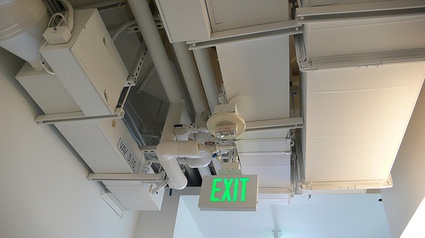
I was impressed beyond words by the mix of lightness, playfulness, critical minds, audacious ideas, social relevance and a great attention to details and aesthetics.
Because I met only 5 students from the course, i will focus on their work while inviting you to check out the project gallery on the DMA website.
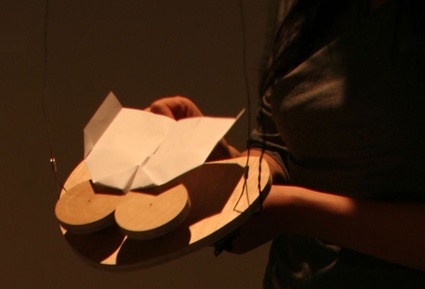
I’ll start with Nova Jiang whom i left a few days ago in cold Milan where she was participating with the project Alternate Endings to the Milan Public Design Festival. Standing in a little pink open house in the street, she invited passersby to leave one piece of garment with her. Using a different coloured fabric each day, she and her team of costume designers and makers replicated exactly the cut and style of the garment and later gave it as a present to the person.
Another of her pieces, the Figurative Drawing Device invites two people to get in close and sometimes disturbingly intimate contact with each other. One of them uses the device to ‘scan’ and draw the outlines of the other person. The imperfect lines preserve not only the presence of the model but also the idiosyncratic movement of the tracer.
Figurative Drawing Device from Nova Jiang on Vimeo
Each drawing can be read as a graph which records the subtle interactions between the two. The drawings can also be multiplied and become a flip book. The process of creating a flip book this way is a performance in endurance for both the subject and the tracer where new psychological patterns emerge.
The Flytrap/Hull Loss from Nova Jiang on Vimeo
Hull Loss –which she just exhibited in The Netherlands– invites participants to make paper airplanes and launch them through a series of mechanically animated scissors.
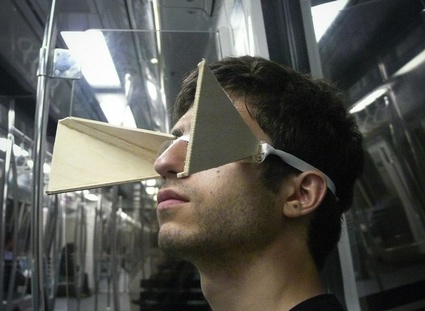 Nova Jiang & Michael Kontopoulos, Objects for Enhancing the Experience of Being Lost
Nova Jiang & Michael Kontopoulos, Objects for Enhancing the Experience of Being Lost
The Objects for Enhancing the Experience of Being Lost, in collaboration with Michael Kontopoulos, address ideas of disorientation in a foreign city, in their case, Singapore. A traveler may tote the objects around in a briefcase, using them to enhance the experience of being lost. One of these objects is a pair of blinders that simulate the experience of tunnel vision at any given location.
Machines that Almost Fall Over from Michael Kontopoulos on Vimeo.
Which brings me to the work of Michael Kontopoulos. Watching his Machines that Almost Fall Over is akin to being in the same room as someone whose favourite hobby is to scratch their fingernails on a blackboard. His wooden sculptures are constantly on the brink of collapse. They swing dangerously, slowly and endlessly but never crash.
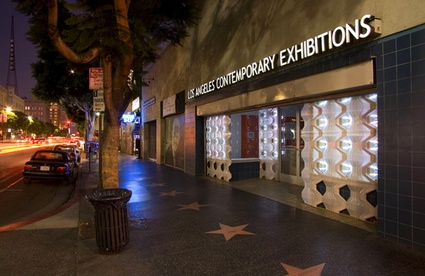 Justin Lui (together with Andrea Boeck and Jihyun Kim) created an amazing installation on the facade of the Los Angeles Contemporary Exhibitions (LACE) gallery in Hollywood.
Justin Lui (together with Andrea Boeck and Jihyun Kim) created an amazing installation on the facade of the Los Angeles Contemporary Exhibitions (LACE) gallery in Hollywood.
OPENINGS is made of system of modular vacuum-formed panels, LCD displays, and LED lights built into both the interior and exterior sides of the storefront wall. White LEDs glow in intensity according to the motion and proximity of pedestrians on Hollywood Blvd’s ‘Walk Of Fame’. LCDs on the exterior side of the wall show animated text describing art exhibits culled from the archives of LACE, while LCDs on the interior show text derived from artist Douglas McCulloh‘s project ‘60,000 Photographs in Hollywood’ describing and quoting various characters encountered on Hollywood Blvd.
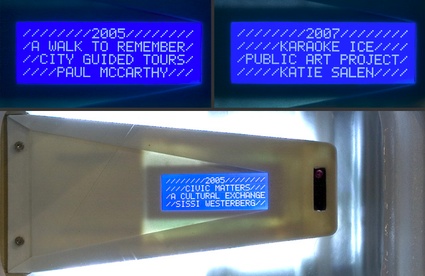
OPENINGS functions as the active membrane between two seemingly at odds zones on either side of the storefront wall, pulling Hollywood Blvd. into LACE gallery and LACE gallery onto the street.
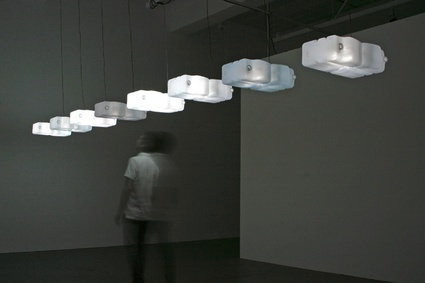 Water Clouds of Light. Discarded water jugs are re-contextualized into a light installation. Objects that used to be cheap and very mundane has been ennobled and seem to float and ‘breathe’ with light. What i like best about the installation is that it is NOT interactive. Why should everything techy be interactive? Video.
Water Clouds of Light. Discarded water jugs are re-contextualized into a light installation. Objects that used to be cheap and very mundane has been ennobled and seem to float and ‘breathe’ with light. What i like best about the installation is that it is NOT interactive. Why should everything techy be interactive? Video.
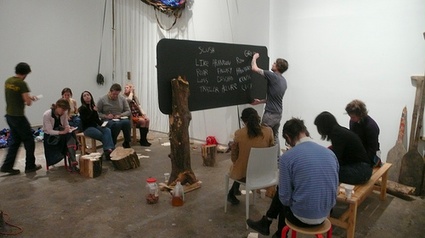 Human Powered Chatbot was a workshop headed by David Elliott and FutureFarmers in Baltimore. 17 people who were given simple rules for processing text and working together. This system created a writing machine that was connected to the internet. Source material was programatically mined from the Twitter and New York Times APIs based on feedback from the participant’s input. The result was a chatbot running on twitter that could interact and respond to conversations online under the guise of a “computer simulating intelligence”.
Human Powered Chatbot was a workshop headed by David Elliott and FutureFarmers in Baltimore. 17 people who were given simple rules for processing text and working together. This system created a writing machine that was connected to the internet. Source material was programatically mined from the Twitter and New York Times APIs based on feedback from the participant’s input. The result was a chatbot running on twitter that could interact and respond to conversations online under the guise of a “computer simulating intelligence”.
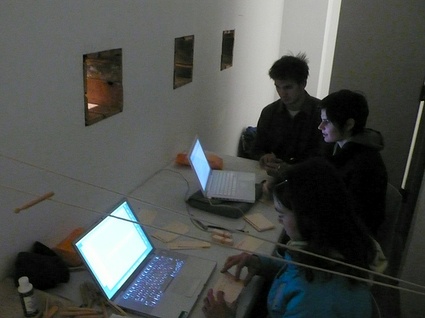 Inside the Fake Computer people are hard at work entering messages into the internet
Inside the Fake Computer people are hard at work entering messages into the internet
Reduced to mere automata in the system, the participants could nevertheless chose to be either Computational Processors (whose job is to extract keywords) or Subjective Processors (who make a text using the keywords). After a message has been passed through the Computational and Subjective Processors, it gets uploaded to the internet where keywords are used as search terms on the New York Times and Twitter websites. The results of the search are returned along with any replies from people trying to talk to the Human Powered Chatbot and everything is copied down onto pieces of paper… and then redistributed to the Computational Processor to complete the loop.
Inspired by A Mathematical Theory of Communication, an article written in 1948 by mathematician Claude E. Shannon.
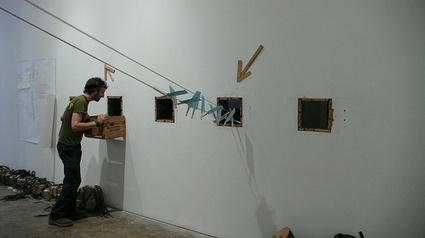 The messenger takes the cards and circulates them back into the system
The messenger takes the cards and circulates them back into the system
To be continued…
